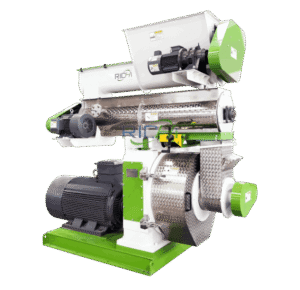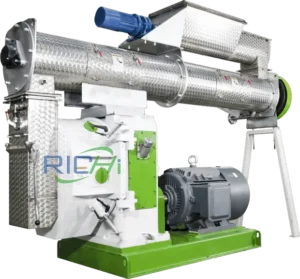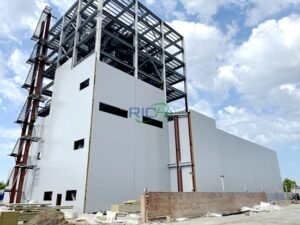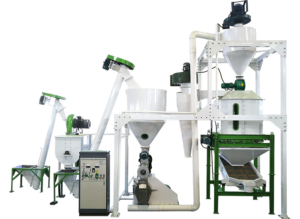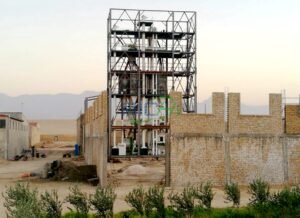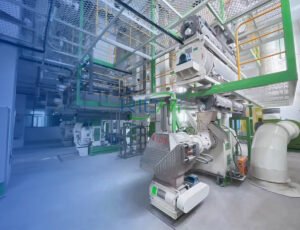
Hay pellet machines have become increasingly popular in recent years, offering numerous benefits to farmers, livestock owners, and those in the biomass fuel industry. These machines efficiently convert loose hay into compact, easy-to-handle pellets, providing several advantages over traditional hay handling methods. This article explores the main advantages of hay pellet machines and why they are becoming an essential tool in modern agriculture and renewable energy sectors.
- Improved Storage Efficiency
One of the primary advantages of hay pellet machines is the significant improvement in storage efficiency:
- Volume Reduction: Hay pellets occupy only about 1/3 to 1/5 of the space required for loose hay, allowing for more efficient use of storage facilities.
- Longer Storage Life: Pelletized hay is less susceptible to moisture and mold, extending its shelf life compared to baled hay.
- Easier Handling: Pellets can be easily stored in silos or bags, simplifying storage and transportation logistics.
This improved storage efficiency translates to reduced costs for warehousing and allows farmers to store larger quantities of feed in limited spaces.
- Enhanced Nutritional Value
Hay pellet machines can contribute to improved nutritional value of the feed:
- Consistent Quality: The pelletizing process ensures a uniform mix of nutrients throughout the feed.
- Reduced Waste: Animals are less likely to sort through or waste pelletized feed compared to loose hay.
- Improved Digestibility: The heat and pressure applied during pelletization can increase the digestibility of certain nutrients.
These factors can lead to better animal health and potentially improved livestock productivity.
- Cost-Effective Transportation
Transporting hay pellets is more economical than moving loose or baled hay:
- Higher Density: More hay can be transported per truckload when in pellet form.
- Reduced Fuel Costs: The compact nature of pellets means fewer trips are needed to transport the same amount of feed.
- Easier Loading and Unloading: Pellets can be handled with automated systems, reducing labor costs and time.
For farmers selling hay or those purchasing feed from distant sources, these transportation efficiencies can result in significant cost savings.
- Versatility in Feed Formulation
Hay pellet machines offer flexibility in creating custom feed formulations:
- Blending Capabilities: Different types of hay or additional nutrients can be easily mixed before pelletization.
- Consistent Ratios: The pelletizing process ensures that each pellet contains the intended mix of ingredients.
- Adaptability: Feed formulations can be quickly adjusted to meet specific nutritional requirements of different animals or changing needs.
This versatility allows for precise control over feed quality and composition, benefiting both livestock health and production efficiency.
- Reduced Feed Waste
Hay pellet machines contribute to significant reductions in feed waste:
- Less Spillage: Pellets are less likely to be scattered or blown away during feeding.
- Improved Palatability: Many animals prefer the texture of pellets, leading to increased consumption and less leftover feed.
- Portion Control: Pellets allow for more accurate measurement and distribution of feed.
By minimizing waste, farmers can reduce overall feed costs and improve the efficiency of their operations.
- Environmental Benefits
The use of hay pellet machines can have positive environmental impacts:
- Reduced Carbon Footprint: More efficient transportation and storage of pellets can lead to lower overall carbon emissions.
- Sustainable Fuel Source: Hay pellets can be used as a renewable biomass fuel, offering an alternative to fossil fuels.
- Waste Reduction: Pelletizing allows for the utilization of hay that might otherwise go to waste.
These environmental benefits align with growing global trends towards sustainability in agriculture and energy production.
- Improved Farm Management
Hay pellet machines can streamline various aspects of farm management:
- Inventory Control: Pellets are easier to measure and track, improving feed inventory management.
- Year-Round Availability: Pelletized hay can be stored for longer periods, ensuring feed availability throughout the year.
- Simplified Feeding Systems: Pellets can be easily incorporated into automated feeding systems, reducing labor requirements.
These management improvements can lead to more efficient and profitable farming operations.
- Market Opportunities
Hay pellet machines open up new market opportunities for farmers:
- Value-Added Product: Pelletized hay often commands a higher price than loose hay.
- Expanded Customer Base: Pellets appeal to a wider range of customers, including small-scale livestock owners and pet owners.
- Export Potential: The compact nature of pellets makes them more suitable for long-distance transportation and export.
These market opportunities can provide additional revenue streams for hay producers.
Conclusion
Hay pellet machines offer a wide range of advantages that address many of the challenges faced in traditional hay handling and feeding practices. From improved storage and transportation efficiency to enhanced nutritional value and reduced waste, these machines provide significant benefits to farmers, livestock owners, and the environment.
As the agricultural industry continues to seek more efficient and sustainable practices, hay pellet machines are likely to play an increasingly important role. Their ability to transform bulky, perishable hay into a compact, stable, and versatile product aligns well with the needs of modern agriculture and the growing demand for renewable energy sources.
For those considering investing in a hay pellet machine, the potential for improved operational efficiency, cost savings, and new market opportunities make it a compelling option. As technology continues to advance, we can expect further innovations in hay pellet machines, potentially offering even greater benefits in the future.
Related post:fully automatic cattle feed plant

